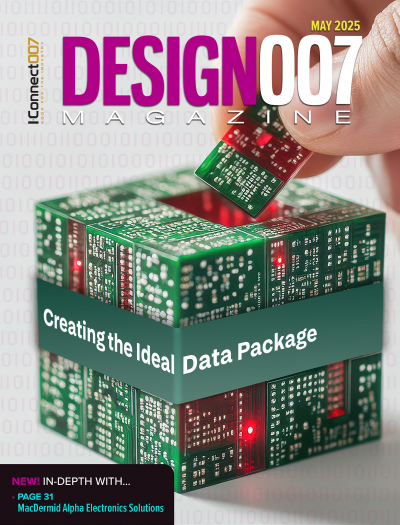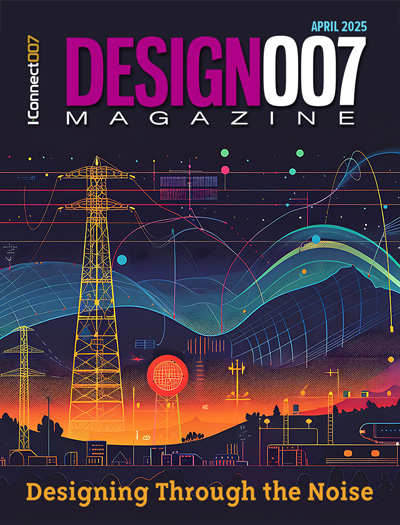-

- News
- Books
Featured Books
- design007 Magazine
Latest Issues
Current Issue
All About That Route
Most designers favor manual routing, but today's interactive autorouters may be changing designers' minds by allowing users more direct control. In this issue, our expert contributors discuss a variety of manual and autorouting strategies.

Creating the Ideal Data Package
Why is it so difficult to create the ideal data package? Many of these simple errors can be alleviated by paying attention to detail—and knowing what issues to look out for. So, this month, our experts weigh in on the best practices for creating the ideal design data package for your design.

Designing Through the Noise
Our experts discuss the constantly evolving world of RF design, including the many tradeoffs, material considerations, and design tips and techniques that designers and design engineers need to know to succeed in this high-frequency realm.
- Articles
- Columns
- Links
- Media kit
||| MENU - design007 Magazine
Effects of PCB Fiber Weave on High-Speed Signal Integrity
December 31, 2018 | Chang Fei Yee, Keysight TechnologiesEstimated reading time: 1 minute
This article studies the effect of PCB fiber weave on signal integrity in terms of mode conversion and differential channel loss due to intra-pair skew. The study used Keysight ADS 2DEM simulation to observe s-parameter (i.e., insertion loss and differential to common-mode conversion) and an eye diagram for signal transmission at 1 Gbps and 10 Gbps.
Introduction
A PCB dielectric substrate is composed of woven fiberglass that is strengthened by epoxy resin. The microscopic top view of PCB substrates of fiber weave 106 and 3313 are illustrated in Figures 1a and 1b. The thick lines in light brown color are fiberglass, while the square columns in black color are an epoxy resin. A higher-numbered configuration (e.g., 3313) denotes denser fiberglass weave.
Fiberglass material features dielectric properties that differ very much from the properties of the epoxy resin. For instance, NE-glass fiber has a dielectric constant (Dk) and loss tangent (Df) of 4.4 and 0.0006, respectively; meanwhile, E-glass fiber has a Dk and Df of 6.6 and 0.0012. Epoxy resin has a Dk of 3.2, which is very different than that of fiberglass. When a substrate with sparse fiber weaving is used, PCB traces could cross different regions of resin and fiberglass more frequently. As a result, the speed or propagation delay of the signal changes frequently along the trace from transmitting to receiving end.
To read this entire article, which appeared in the November 2018 Design007 Magazine, click here.
Suggested Items
I-Connect007 Editor’s Choice: Five Must-Reads for the Week
06/06/2025 | Nolan Johnson, I-Connect007Maybe you’ve noticed that I’ve been taking to social media lately to about my five must-reads of the week. It’s just another way we’re sharing our curated content with you. I pay special attention to what’s happening in our industry, and I can help you know what’s most important to read about each week. Follow me (and I-Connect007) on LinkedIn to see these and other updates.
INEMI Interim Report: Interconnection Modeling and Simulation Results for Low-Temp Materials in First-Level Interconnect
05/30/2025 | iNEMIOne of the greatest challenges of integrating different types of silicon, memory, and other extended processing units (XPUs) in a single package is in attaching these various types of chips in a reliable way.
Siemens Leverages AI to Close Industry’s IC Verification Productivity Gap in New Questa One Smart Verification Solution
05/13/2025 | SiemensSiemens Digital Industries Software announced the Questa™ One smart verification software portfolio, combining connectivity, a data driven approach and scalability with AI to push the boundaries of the Integrated Circuit (IC) verification process and make engineering teams more productive.
Cadence Unveils Millennium M2000 Supercomputer with NVIDIA Blackwell Systems
05/08/2025 | Cadence Design SystemsAt its annual flagship user event, CadenceLIVE Silicon Valley 2025, Cadence announced a major expansion of its Cadence® Millennium™ Enterprise Platform with the introduction of the new Millennium M2000 Supercomputer featuring NVIDIA Blackwell systems, which delivers AI-accelerated simulation at unprecedented speed and scale across engineering and drug design workloads.
DARPA Selects Cerebras to Deliver Next Generation, Real-Time Compute Platform for Advanced Military and Commercial Applications
04/08/2025 | RanovusCerebras Systems, the pioneer in accelerating generative AI, has been awarded a new contract from the Defense Advanced Research Projects Agency (DARPA), for the development of a state-of-the-art high-performance computing system. The Cerebras system will combine the power of Cerebras’ wafer scale technology and Ranovus’ wafer scale co-packaged optics to deliver several orders of magnitude better compute performance at a fraction of the power draw.


